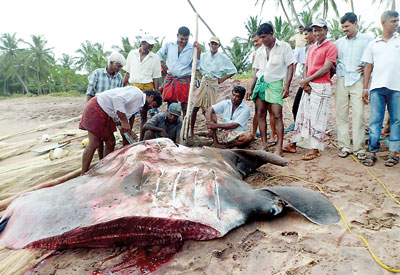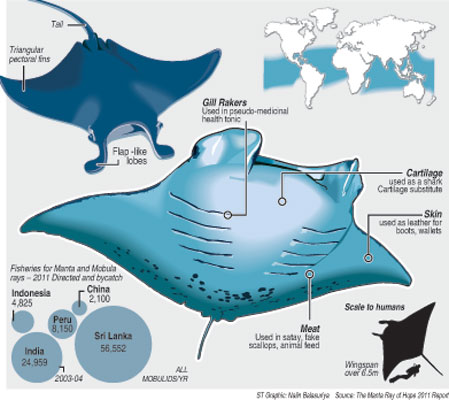News
Manta ray struggles for survival
View(s):Overfishing threatens the magnificent and prized ‘Ali Maduwa’, writes Malaka Rodrigo
A giant “maduwa”, or manta ray, was netted last week by fisherman in Welipatanwila, Ambalanthota, on the South coast. The ocean creature was pregnant and weighed 1,500 kilograms. A week earlier, another manta ray was caught by fishermen in Akkaraipattu, on the East coast. Both sea creatures have been identified as Giant Oceanic Manta Rays, the largest member of the ray family.

“Maduwa”, or manta ray, that was netted last week by fishermen in Welipatanwila, Ambalanthota, on the South coast
The Giant Oceanic Manta Ray was a common catch a decade ago, but the creature is steadily becoming less common. Known locally as “Ali Maduwa”, the creature is hunted primarily for its gill plates, which are extracted, dried and exported. Dried gill plates are widely used in Chinese traditional medicine. A kilogram can fetch between Rs.15,000 and Rs. 20,000. The manta ray uses its cartilaginous gill plates to filter the plankton that it lives on. The delicate gill filaments also play a role in the manta ray’s breathing system.
Manta rays are slow breeders with long lives. The animal, which can live to 50 years (some are known to have lived to 100 years), has a gestation period of more than a year and gives birth to just one single pup. Young mantas take between 10 and 15 years to reach sexual maturity.
“Manta ray populations simply cannot survive the current level of commercial fishing,” says manta expert Daniel Fernando. “Any target fishing that annually removes even a relatively small percentage of the breeding adults results in a rapid decline in overall populations within a few years. The remaining mature rays cannot breed fast enough to replace those lost to fishing. Manta rays in our waters are already in decline. Fishermen say they rarely catch large mantas in our waters any more.”
Daniel Fernando works for the Sri Lanka Manta Project (Manta Trust) and collects manta ray landings data for his research. Most of the time mantas are a bycatch of gill nets, says Dr. Rekha Maldeniya, a marine fish expert who works for the National Aquatic Research and Development Agency (NARA). “Our fishermen do not like it when these large creatures get entangled in their nets, because they can damage the net.”
The manta ray comprises only 1 per cent of large pelagic fish catch, such as tuna, Dr. Maldeniya says. “NARA identifies the importance of skates and rays, but we don’t have the funds to carry out comprehensive research on these sea animals.”
Daniel Fernando of Manta Trust says fishermen can release manta rays that get entangled in their nets, but do not because they know the commercial value of the manta’s gill plates. He says the manta would be spared if fishermen used other sustainable methods of fishing, such as the pole-and-line tuna fishing method practised in the Maldives. The gill-net is one of the least sustainable of fishing methods, he adds.
Sri Lanka, like most countries, has not reported manta ray landings to world bodies such as the United Nations Food and Agriculture Organization (FAO). Researchers believe Sri Lanka is among the leading countries that fish manta rays, and the closely related Devil Ray. There is hope on the horizon for the rays if the Convention on International Trade in Endangered Species (CITES) makes a global decision on manta exploitation.
Ecuador, Colombia, and Brazil have proposed that the two manta ray species be listed under CITES, an international treaty drawn up in 1973 to prevent international trade from threatening animals and plants in the wild. Proposals to list manta rays and scores of other species in the CITES list will be discussed in March at the 16th Conference of Parties (COP16) to CITES. CITES has 177 member countries, including Sri Lanka. A two-thirds majority vote is required for the adoption of listing proposals. If this is agreed, Sri Lanka will have to introduce a permit system for the export of manta ray gills, a step that would help monitor and manage this particular fishery.

Manta expert Daniel Fernando said the move was directed at international trade and would not affect Sri Lankans fishing for local consumption. The move would help manage manta ray populations. Alternatives, such as manta ray tourism, as practised in the Maldives, would bring long-term benefits. Mr. Fernando said a workshop on manta rays was held in Colombo for CITES delegates. It was attended by major countries in the region, including India, Bangladesh, Bhutan, Nepal, Indonesia, and the Maldives. All participants were positive about regulating the manta ray fishery.
In 2011, Shark Advocates International president Sonja Fordham met senior Sri Lankan officials to discuss shark and manta ray conservation.
Ms. Fordham was a leading figure in bringing the Giant Manta Ray under the Convention of Migratory Species (CMS). Through this listing, Sri Lanka and all CMS parties with giant mantas in their waters have agreed to protect the species and cooperate in preserving manta habitats.
Sonja Fordham says equal efforts should be extended to protect the oceanic whitetip sharks and three species of hammerhead, all of which are found and fished off Sri Lanka.
“We are hopeful Sri Lanka will participate in the CITES meeting and support the listing of these vulnerable shark and ray species,” Sonja Fordham told the Sunday Times.
“Support from Sri Lanka would send a positive signal about the country’s commitment to sustainable exploitation of marine resources and can help secure a much-needed global safeguard, before it’s too late.”
Follow @timesonlinelk
comments powered by Disqus
















